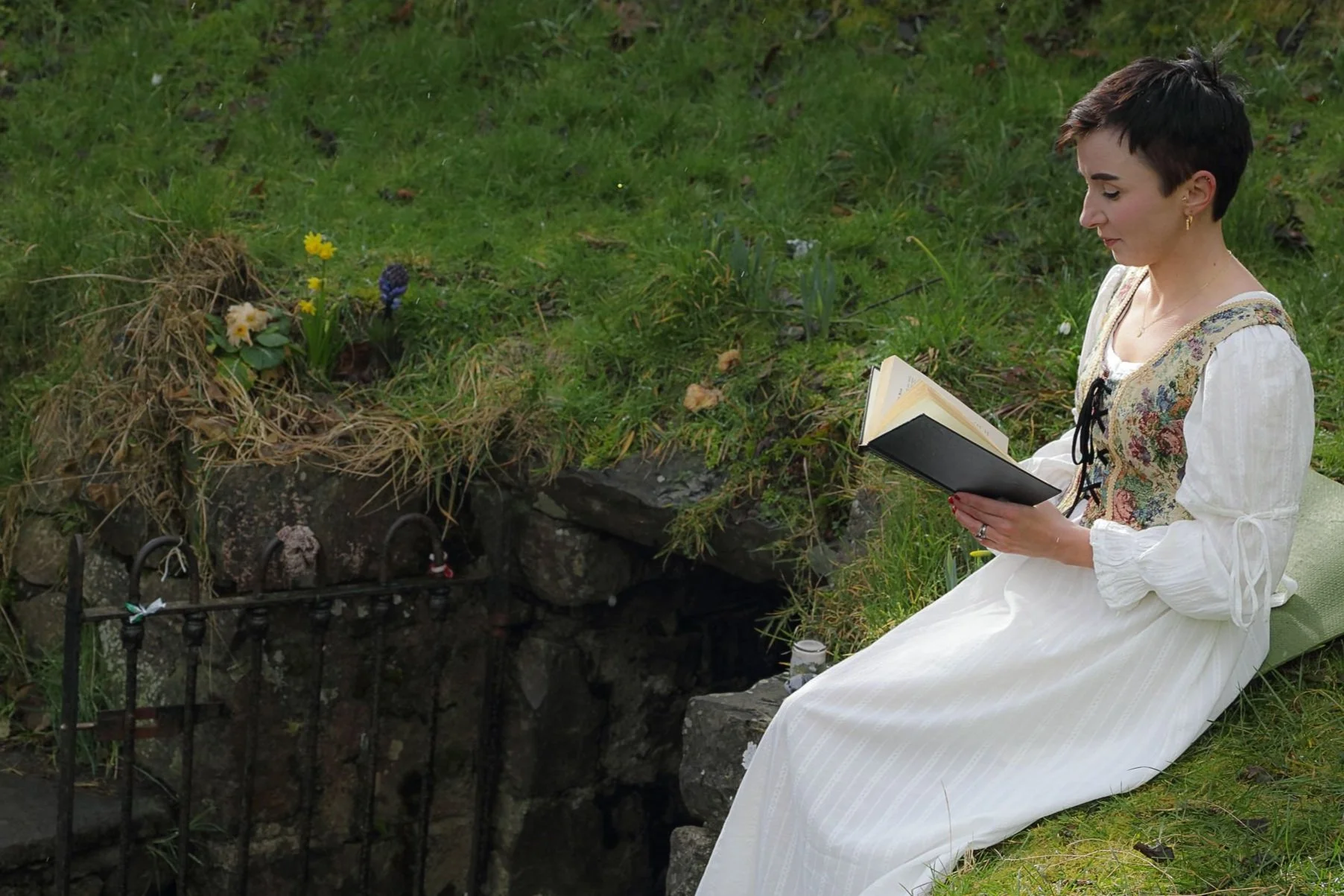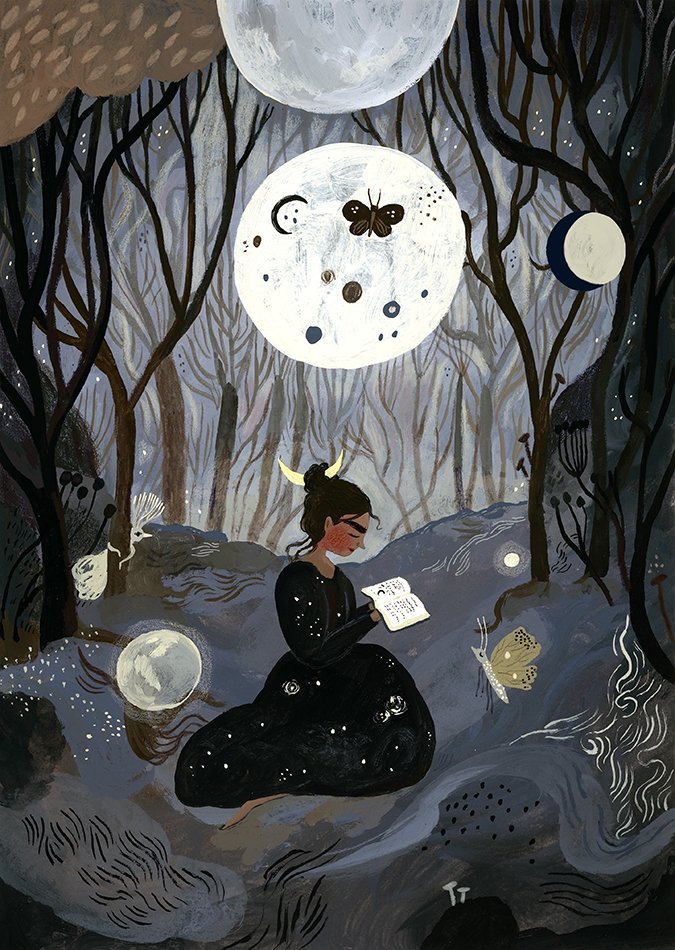
MUSINGS FROM THE OTHERWORLD
My current writings and musings on Celtic feminine mysticism and soulful living now find their home on Substack. I invite you to join me there but I’ve also preserved an archive of my previous writings (2021-2023) below.
A Letter Writing Ritual
These letters were given to me after my Gran passed 15 years ago, they were found among others that I wrote in a treasured box she kept. She is now a well and wise ancestor who I feel as deeply connected to as when she was alive. And so this winter, I am continuing to write to her sharing about my inner and outer landscapes.
Art by Johannes Rosierse
“You have a touch in letter writing that is beyond me. Something unexpected, like coming round a corner in a rose garden and finding it still daylight.”
Virginia Woolf
Recently, I found a letter posted on 21st June 1999, the summer solstice in the last year of that decade, that I sent to my grandmother, Frances O’Sullivan, my gorgeous “Gran”. I was a teenager at the time away without my family studying Gaeilge/Irish in the Gaeltacht in Co. Donegal. This was my third summer to go away to study Irish and so I was used to the experience by this stage.
As my eyes fall upon my own writing, it’s curious to read now 24 years later what was happening in my inner landscape… how I was feeling, the small little revelations I was having about the language, an experience of a “blind date” that made me laugh so much I was nearly sick, something I have no recollection of now (it must have been a school sketch or show we put on)!
I also shared about my outer landscape, about the Bean an Tí, the “Woman of the House” and her small children who were the age that my own children are now. How they were bilingual and adorable. The Céilí’s, the dances each night and the craic of losing the run of ourselves, swinging one other so hard that we’d take flight during The Siege of Ennis (one of the dances).
These letters were given to me after my Gran passed 15 years ago, they were found among others that I wrote in a treasured box she kept. She is now a well and wise ancestor who I feel as deeply connected to as when she was alive. And so this winter, I am continuing to write to her sharing about my inner and outer landscapes.
Letter Writing Ritual
This is an invitation to write a letter to a well and wise ancestor or a mythic ancestor this Samhain. For example, you might like to write to the Cailleach, the Gaelic Goddess, our Seanmháthair Naofa, our Sacred Grandmother, who is deeply associated with these winter months in Ireland/Éire, the Isle of Man/Ellan Vannin and Scotland/Alba. Or whoever calls to you at this time, listen and you’ll hear them whisper.
The Tradition by Julia Jeffrey
Open up your ritual space before you write, light a candle to honour the flame of your lineage, both clan and mythic ancestors.
Remember, when you handwrite, you are literally shaping your words with your body. Your handwriting is utterly unique to you, and so as you write in ways you create and recreate yourself.
Share with your ancestor about what’s happening in your inner landscape, your world of thoughts, emotions, feelings, sensations and intuitions.
Then share about your outer landscape, what is happening beyond your window in the world? How does the outer world relate back to your inner world?
Write with free abandon in full honesty so as not to lie to yourself or to your ancestor.
What guidance would you welcome in a return letter from your ancestor? This may come to you in the form of a dream, a synchronicity, an intuitive spark - a mirroring back to you.
If ever there’s been a time to remember our global interconnectedness, it is now. Let the Goddess be your guide.
The Otherworld by Tijana
Once you have written your letter, you can place it in an envelope, even address it if you like, allow the spell of your imagination to work its wonder.
Then place your letter on your altar, or a sacred space, or you can write a series of letters and continually wrap them in string. You will know what to do. They are your keepsakes.
In time, reopen your letter and journal in response to the guidance that did come to pass. Perhaps at the Winter Solstice or Imbolc or whatever season you find yourself in.
“She is ideas, feelings, urges, and memory. She has been lost and half-forgotten for a long, long time. She is the source, the light, the night, the dark and daybreak… She is the one we leave home to look for. She is the one we come home to.”
Clarissa Pinkola Estés
Voices of Celtic Wisdom
I am thrilled that I will be joining the teaching team of Voices of Celtic Wisdom. This is a 4-month programme exploring living threads of the earth-based cultures of Ireland, Scotland, England and Wales with song, story, lore and hands-on crafting workshops.
Other teachers include Dolores Whelan, Manda Scott, Angharad Wynne, Tara Brading, Mary McLaughlin, Danu Forest, Dougie MacKay, Seoras Macpherson… and more wondrous souls.
The programme runs from 30th November 2023 to 25th March 2024.
The Cailleach’s Return
I take you back to 8th century Ireland. Christianity is growing on our island and the epoch of the Sovereignty Goddess is ending. The Old Woman of Beare laments, “Ebbtide to me as to the sea…”
This week, I felt the promise of the Cailleach’s energy. She is coming. As I stood in Loughcrew on the Autumn Equinox and watched the blood-orange sun rise up to greet me on Sliabh na Caillí, ‘The Cailleach’s Hill’, while the waning moon hung behind, it felt like she was coordinating this cosmic dance preparing for her return. Her light filled Cairn T, a 5,000 year old passage tomb and ritual complex, illuminating its central chamber, the Cailleach’s womb.
THE VEILED ONE
Cailleach (“KAL-yach”) means ‘Veiled One’ in Old Irish. It is also the modern Irish word for a ‘witch’ but the English translation does not serve fully, as even in its modern form, Cailleach is imbued with the essence of ‘divine hag’.
We have no creation myth in the Irish tradition, lost to the realms of time or perhaps to the censorship of Christian monks who first captured our oral tradition in written word. But it is said that the Cailleach created the cairns, the mountains, their infant hills; this land by dropping rocks out of her apron.
She is as old as time. She is our creator deity, our ancestor deity, our weather deity. She is our Bean Feasa; our wise, curing woman. She is a Sovereignty Goddess, a fierce protectress of this land that she shaped. Arriving through the portal of Samhain and reigning over winter until Brigid comes at Imbolc. She is a shapeshifter. Often appearing in the form of a hare, a magical animal that possesses the gift of superconception - the ability to get pregnant while pregnant.
‘The Cailleach of Loughcrew’ by Shelly Mooney, Tales from the Wood
THE OLD WOMAN OF BEARE
One of the oldest known expressions of the Cailleach comes from the Beara peninsula in the southwest of Ireland, in the form of the 8th century poem, ‘The Lament of the Old Woman of Beare’. Its composer is thought to be the historical woman poet, Digde. The prose introduction to the poem reads:
‘The Old Woman of Beare, whose name was Digde, was of the Corcu Duibne [a tribe of Western Co. Kerry]... This is why she was called the Old Woman, the Nun of Beare: she had fifty foster-children in Beare. She passed into seven periods of youth, so that every husband used to pass from her to death and old age, so that her grandchildren and great-grandchildren were peoples and races. And for a hundred years she wore the veil…’
So we can see here the allusion to the Cailleach as a Creator Goddess, as mother of peoples and races. The reference to fosterage is notable as it is a key theme in Celtic mythology and is reflective of the practice in early Irish society. Children were fostered by Goddesses and Gods and mythical mentors who would teach them skills to amplify their human gifts and their supernatural capacities.
Photos I took on Dursey Island (Oileán Baoi) in 2019
A LAMENT FOR THE GODDESS
What is even more fascinating is the poem itself, where the dance of polarities at this time of year is reflected in the Old Woman of Beare’s own body. It is the 8th century, Christiany is now in Ireland three centuries and growing. The ancient ways of the Goddess are dissolving, relegated to a ‘pagan’ past. And so, the old woman laments:
Ebbtide to me as to the sea; old age causes me to sallow; although I may grieve thereat, it comes to its food joyfully.
I am the Old Woman of Beare, from Dursey; I used to wear a smock that was always new. Today I am become so thin that I would not wear out even a cast-off smock.
Bitterly does my body seek to go to a dwelling where it is known; when the Son of God deems it time, let Him carry off his deposit.
When my arms are seen, all bony and thin! - in fondest fashion they acted, once; they used to be around glorious kings.
When my arms are seen, all bony and thin, they are not, I declare, worth raising up over handsome boys.
They girls are joyful when they approach Maytime; grief is more fitting for me: I am not only miserable, I am an old woman.
Woe is me indeed - every acorn is doomed to decay - to be in the darkness of an oratory after feasting by bright candles.
I have had my time with kings, drinking mead and wine; today I drink whey and water among shrivelled old women.
My flood has guarded well that which was deposited with me; Jesus, Son of Mary, has redeemed it so I am not sad up to ebb.
Happy the island of the great sea; flood comes to it after ebb; as for me, I expect no flood after ebb to come to me.
Today, there is scarcely an abode I would recognise; what was in flood is all ebbing.
Through her poignant expression, we learn that the Old Woman of Beare desires to die, to be carried off when the Son of God deems it time. And yet, she was once a God, a Goddess herself, not a shrivelled old woman. She sits in an oratory of darkness but she used to drink mead and wine with glorious kings, wrapping her arms around them.
Here, she laments the Banais Ríghí (“BAN-ash REE-ghee”), meaning, ‘Wedding-feast of Kingship’. This was the highest form of ceremony in Ancient Ireland. A marriage between the king who represented people and culture, and the Sovereignty Goddess who represented nature and the land. In this ritual, the Goddess would offer the king a wedding libation (liquid or grains poured from the cup of a deity) to indicate her approval of the marriage and the king’s legitimacy to rule. This was the perfect union of the masculine with the divine feminine.
‘Cailleach an Mhuilinn’, The Hag of the Mill by Jane Brideson
THE CAILLEACH’S RETURN
The old woman’s mortal body may have been carried off in the 8th century. Yet, her essence as the Cailleach, as our creator deity and landshaper continues to reverberate deep in the sovereign soul of this island. Each Samhain, she has returned to us to rule over winter. We never lost her. Her imprint lives on through us. It is growing. Her power is growing. Can you feel her?
She is here in this time to reclaim her role as Sovereignty Goddess, as we reclaim our own sovereign power as women.
She is here to guide us home.
Sources:
The Book of the Cailleach: Stories of the Wise-Woman healer by Gearóid Ó Crualaoich
















